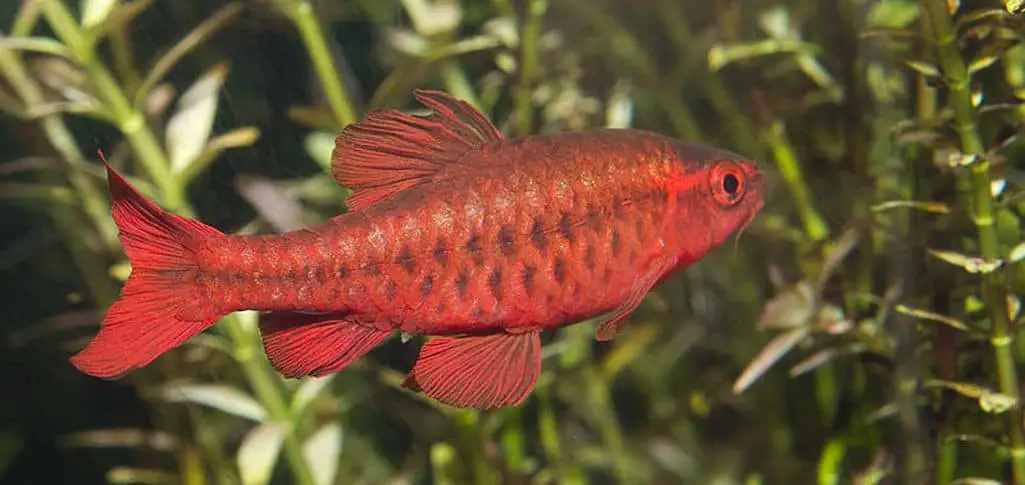7 Best Red Tail Shark Tank Mates (With Pictures)
The Red Tail Shark is popular for its impressive looks – it has a full black body and a vibrant red forked tail.
Despite what its name suggests, the Red Tail Shark is actually a kind of carp and is a part of the Cyprinidae family. It is not a shark.
However, its dorsal fin is quite similar to that of a shark, and this is why it has been named a Red Tail Shark.
These fishes are known to be somewhat precarious and aggressive.
They are territorial by nature and can become hostile if other fishes try to disturb its feeding session or enter its territory.
This is why you need to be very careful while selecting the other fishes that will be a part of your community tank.
Ideal tank mates must be fast, robust, and prefer spending their time in the upper and middle parts of the water column.
If you are still confused, then go through the below-given list of the best Red Tail Shark tank mates, and you are sorted.
Table of Contents
Bala Shark

Bala Shark, also known as Silver Shark, Tricolor Minnows, Tricolor Shark, and Silver Bala, is a part of the Cyprinidae family.
Just like Red Tail Shark, it is not a shark but is called so because of its body type and high dorsal fin, which is quite like that of a shark.
Bala Sharks are pretty tolerant towards other little fishes, as long as they are not so little that can be swallowed by them.
These sharks have a torpedo-like, elongated body, and their fins have black edging and yellowish stripes. Their body is grey in color and has a little gradient near the top, and it is a little brighter towards the bottom.
Also, what will attract your attention is their eyes, which are pretty big. It helps them focus on big areas and also is useful for hunting.
Bala Sharks are quite peaceful by nature, and you can keep them with other peaceful fishes.
You can keep them along with other Bala Sharks, Tetra, Minor Tetra, Char, Rasbora, Gourami, Rainbowfish, and Corydoras. Also, Bala Sharks are said to be one of the best Red Tail Shark tank mates.
Just make sure not to introduce any carnivorous species like large cichlids, and nor should you add any small species like neon tetras.
Barbs
Barbs are colorful, active fishes and belong to the Cyprinidae family.
They greatly vary in size, from the Tinfoil Barb that can grow more than a foot long to the tiny Gracilis Barb that is less than an inch in size.
These fishes are known as fin nippers, particularly owing to the behavior of some types like Rosy Barbs, Black Ruby Barbs, and Tiger Barbs.
Though some species can be over-active, there are also some that are peaceful like Gold, Checkerboard, Pentazona, and Cherry Barbs.
Female Barbs are heavy-bodied and larger, while the males are more colorful and smaller.
Barbs are almost always active, and so they should be kept in a tank with fishes with the same activity levels and similar size.
As already mentioned, some Barbs are known to nip at each other to communicate.
You should avoid mixing such fishes with those that are slow-moving, long-finned, or timid like Neon Tetras, Bettas, Guppies, and Angelfish.
Depending on the type of Barbs you have adopted, Red Eye, Serpae, Rainbow Sharks, Black Skirt Tetras, Danios, Red Tail Shark, and other Barb species will make perfect tank mates.
Danios

Danios belong to the Cyprinidae family and are schooling fish. Most species grow less than 2-inches in size and are usually surface oriented.
There are some species, though, that can grow up to 5-inches in length like Giant Dailos and Dangila.
These fishes are very hardy, can tolerate a great range of water chemistry and temperature, and thus are an ideal choice for newly set up and beginner tanks.
They are also very active by nature. However, they hardly ever cause any injury to their companion fishes.
Since Danios are almost always active, you should ideally keep them along with other active fishes.
Some good tank mates include Red Eye, Serpae, Platies, Black Skirt Tetras, Swordtails, Mollies, and other Danios and Barbs.
They are even considered to be among the best Red Tail Shark tank mates.
Angelfish
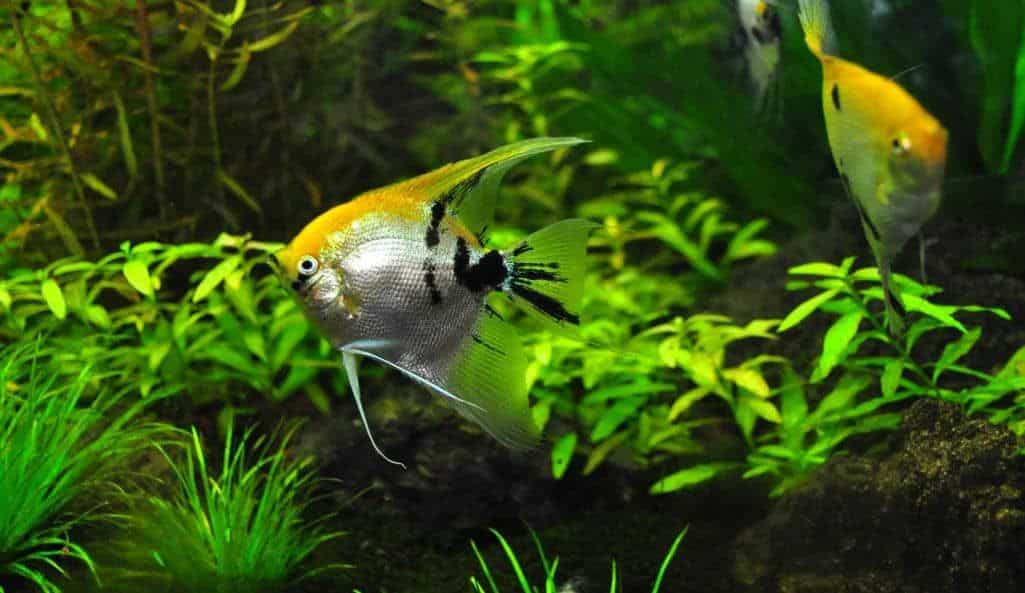
They are one of the most popular freshwater fish as far as aquarium hobby is concerned.
Angelfish is a part of the Cichlidae family and is loved by hobbyists for their graceful swimming. They serve as perfect additions to any large community aquarium.
Usually, wild-caught Angelfish are not found in aquariums. Most of the fishes that are sold are captive-raised. In the wild, you will find Angelfish with black and silver vertical stripes.
But, owing to selective breeding, various color patterns and also long-finned types, called the ‘veiltails’ are now found present in many community tanks.
An Angelfish is generally peaceful. However, they are cichlids and may turn aggressive towards each other, particularly when pairing off and spawning.
They even are known to eat little fishes. But, this does not indicate that they are aggressive. They are simply opportunistic and eats whatever can fit into their mouth.
Some ideal tank mates for Angelfish are large Rasboras and large Tetras, Gouramis, Rainbowfish, Peaceful Barbs, medium-sized Catfish, Corydoras, and Red Tail Sharks.
You may even keep Angelfish with Discus in bigger tanks, provided you maintain a temperature above 82-degrees Fahrenheit.
Gouramis
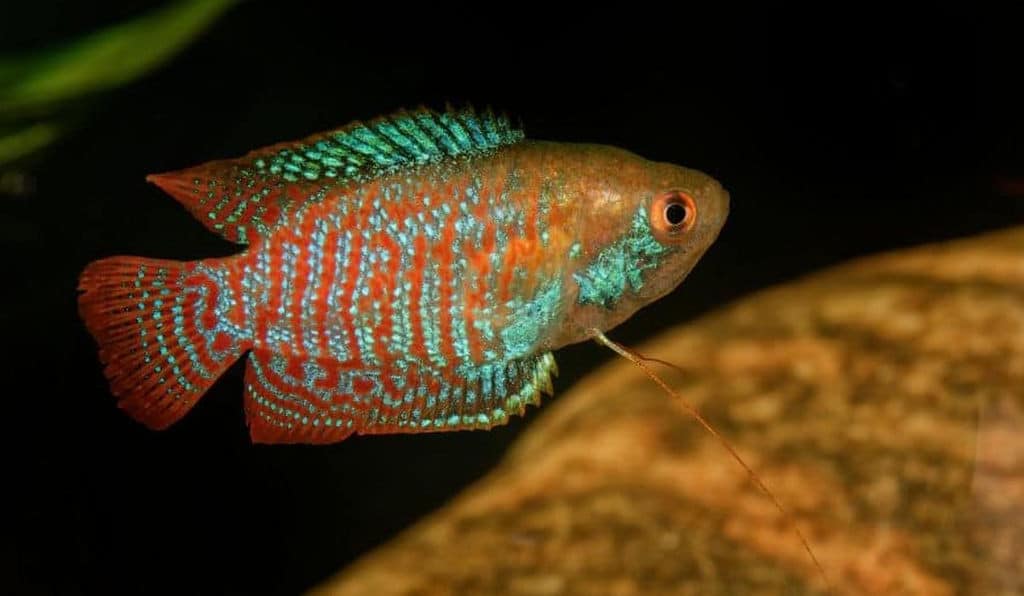
Gouramis are a group of fish belonging to the Anabantidae, Helostomatidae, and Osphronemidae families.
What makes them different is their labyrinth organ, which behaves like a lung and helps them to breathe when at the surface.
Owing to this nature, they are easily able to live in stagnant, oxygen-poor, and shallow water
Certain Gouramis are mouthbrooders, and there are also some that create bubble nests right at the surface in order to protect their eggs till they hatch.
Male Gouramis generally are larger and have longer fins and brighter colors compared to the females.
Many species are even selectively bred for fancier fins and varied colors.
Gouramis generally are aggressive towards one another and thus are best kept individually. Female Gouramis are known to be usually tolerant of each other.
If you plan to mix different color varieties or species of Gouramis, do so only in a well-decorated big aquarium.
Remember that Lavender, Gold, Opaline, Three Spot, and Blue Gouramis are the same. Only, they have been bred for these different colors.
As these fishes are slow-moving, it will be best to keep them in a tank with similar-sized fishes that are neither too active and nor fin nippers.
Livebearers (apart from Fancy Guppies), larger Tetras, Peaceful Barbs, Angelfish, Red Tail Sharks, and most Danios will prove to be perfect tank mates.
Tetras
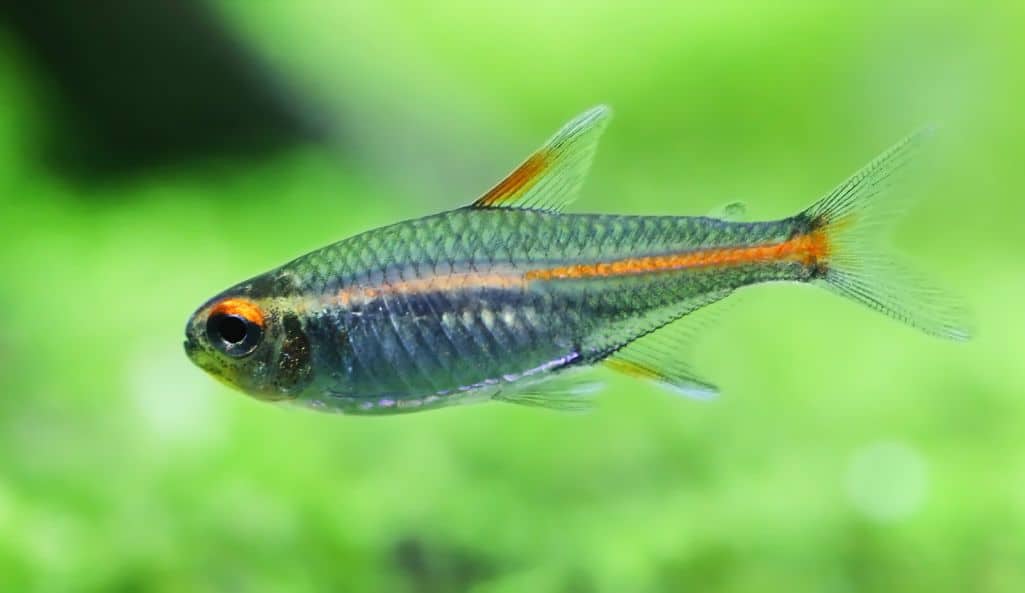
Tetras are schooling fish belonging to the Characidae family and are one of the best Red Tail Shark tank mates.
They are colorful, calm, and generally peaceful, thus making them a good choice for advanced hobbyists as well as beginners.
Some famous beginner Tetras include Red Eye, Black Skirt, Bloodfins, and Serpae. Black Neons, Neons, Lemon Tetras, and Glowlights also make good choices.
Others like Penguin Tetra, Emperors, and Cardinals are comparatively challenging to maintain.
Most Tetras are peaceful and easily get along with community fishes of similar size, though there are some exceptions.
For instance, Serpae Tetras can, at times, be nippy, particularly if you keep them in insufficient numbers.
Good tank mates for Tetras include Rasboras, Peaceful Barbs, appropriately sized Livebearers and Rainbowfish, and other species of Tetras.
White Cloud Mountain Minnow
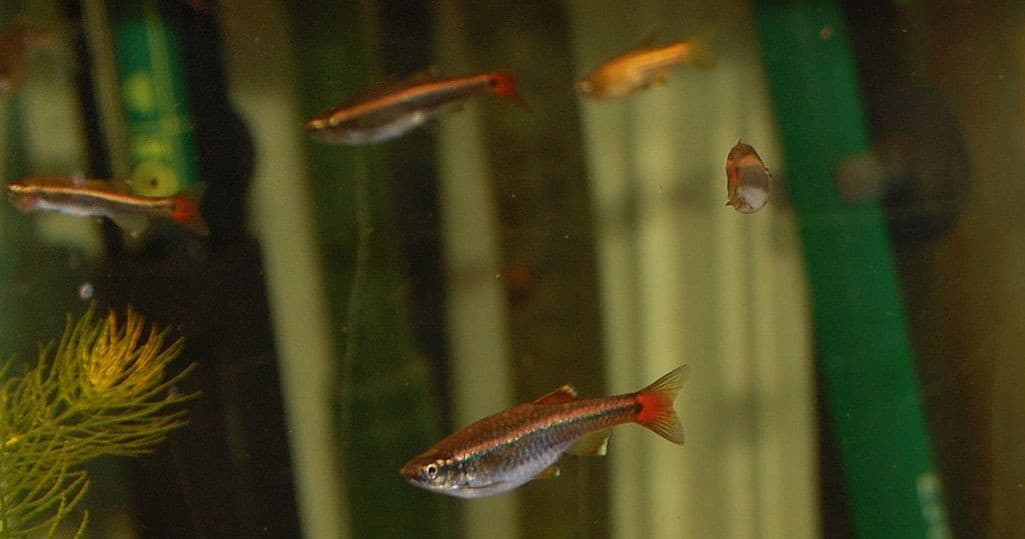
White Cloud Mountain Minnows are colorful, small fishes and are popular for their beauty.
Their scales reflect many different colors and make them look immensely attractive. These fishes are not too messy, easy to take care of, and work perfectly well in community tanks.
Such fishes should ideally be kept in proper-sized schools, a minimum of half a dozen, or maybe more.
If you just keep one, then they will usually hide and also lose their color. They are peaceful with other peaceful small fishes.
Try not to include big tank mates as they may want to eat the White Cloud Mountain Minnows.
Some good tank mate options for these fishes include Paradise Fish, Rosy, and Cherry Barbs. They also do well with Red Tail Sharks.
Community Tank with Red Tail Shark – Few Important Things to Learn
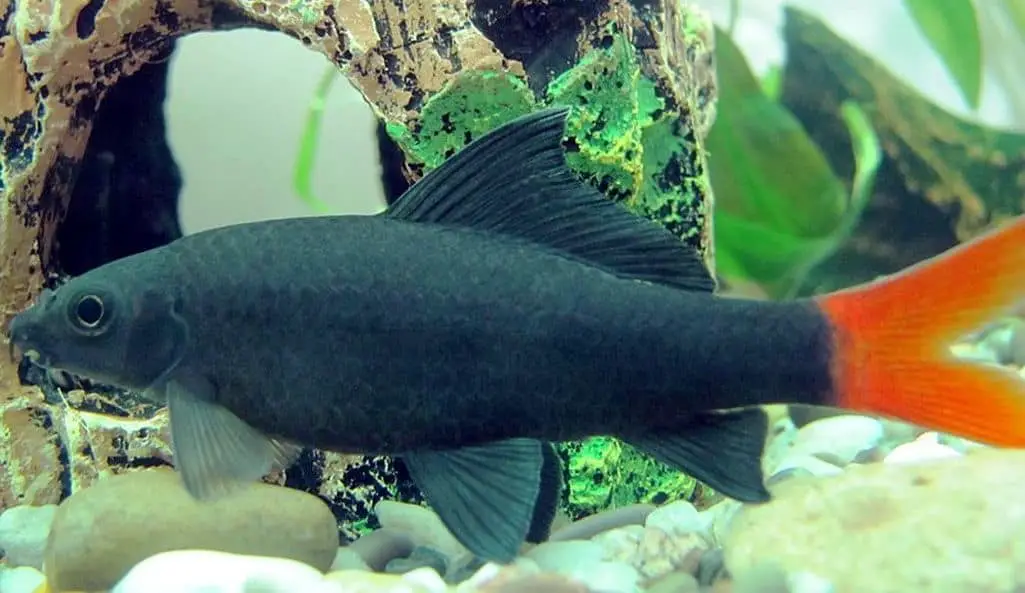
1Decorating a Red Tail Shark Community Tank
Decorating a Red Tail Shark Community Tank
While setting up your Red Tail Shark aquarium, see to it that it is fully decorated with caves and has other hiding spots.
You can amply plant it with many live plants and various fixtures that offer the Red Tail Shark enough place to dart into when other fishes become aggressive.
It is very easy to recreate the natural habitat of a Red Tail Shark in your own tank by designing a quick flowing water stream and keeping a bottom substrate of different sizes. You can opt for a combination of stones, pebbles, gravel.
And, also add some branches or tree roots to help imitate the natural environment that the Red Tail Sharks live in. You may even consider adding some water plants like Anubias or Microsorum.
Make sure your aquarium is properly lit. This will help support active algal growth, which is necessary for your Red Tail Shark community tank.
Since these fishes do not prefer eating live plants, you will not need to worry about the plants that you have introduced to your aquarium.
2Tank and Water Requirements
Tank and Water Requirements
If you have a very big aquarium with lots of hiding spaces, then you can add many red tail sharks and companion fishes. But, remember that each individual fish will require a good part of your aquarium’s length.
It will be a wise idea to divide your aquarium to limit aggressive or territorial behavior. This will help make sure the other companions stay protected, and there will be no chances of injuries due to fighting.
You can make use of driftwood, caves, and other decorations to keep the fishes away from one another. Also, use a weighted lid for your tank, as these fishes might try to jump out.
The temperature in your aquarium needs to be warm, somewhere between 72 – 79 degrees Fahrenheit. The preferred pH level is 6.8 to 7.5, and the water hardness rating must be 5-15 dH.
These fishes do not have any specific filtration needs. Just make sure you have a filter that offers good filtration.
3Care and Maintenance
Care and Maintenance
Clean out their habitat once every week. Make sure to get rid of any food that they have not finished off within two hours.
The tail fins of the Red Tail Sharks become dull red if something is wrong or if they are stressed. As they are active by nature, you may assume they are sick when they start floating aimlessly and do not look busy.
Apart from checking their energy levels and the color of their fins, also keep a check on the condition of their fins. They should not look frayed, shredded, or even have holes.
This may have an effect on their overall health. Even if you notice them gulping, that too may indicate that something is wrong.
While keeping track of the health of your Red Tail Sharks, do not forget this is a community tank, and you have other fishes too. They need equal attention and care.
Conclusion
Red Tail Sharks are rare and beautiful and a perfect addition to any tank. They are not too difficult to take care of, and thus, they make a good choice even for beginners. But, you have to be very, very careful, as they are aggressive by nature.
Now that you are even aware of the best Red Tail Shark tank mates, you also do understand that building a community tank with these fishes is a little difficult, but possible indeed.
If you have a tank that is quite big, then you likely will have no problem at all. And, if you are able to divide your aquarium, then even better.
Just some wise planning, a little extra attention, the right selection of companion fishes, and a good-sized tank will ensure your Red Tail Sharks, as well as its companions, stay together happy and healthy always.

